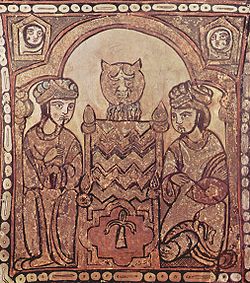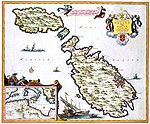
Back تاريخ الإسلام في جنوب إيطاليا Arabic দক্ষিণ ইতালিতে ইসলামের ইতিহাস Bengali/Bangla Historia del islam en el sur de Italia Spanish تاریخ اسلام در جنوب ایتالیا Persian Histoire de l'islam en Italie French Storia dell'islam nell'Italia medievale Italian جنوبی اٹلی وچ اسلام دی تریخ PNB História do islã no sul da Itália Portuguese Istoria Islamului în sudul Italiei Romanian История ислама в Южной Италии Russian

| History of Italy |
|---|
 |
|
|
| History of Malta |
|---|
 |
|
|
The history of Islam in Sicily and southern Italy began with Arab colonization in Sicily, at Mazara, which was captured in 827.[1] The subsequent rule of Sicily and Malta started in the 10th century.[2] The Emirate of Sicily lasted from 831 until 1061, and controlled the whole island by 902. Though Sicily was the primary Muslim stronghold in Italy, some temporary footholds, the most substantial of which was the port city of Bari (occupied from 847 until 871), were established on the mainland peninsula, especially in mainland southern Italy, though Arab raids, mainly those of Muhammad I ibn al-Aghlab, reached as far north as Naples, Rome and the northern region of Piedmont. The Arab raids were part of a larger struggle for power in Italy and Europe, with Christian Byzantine, Frankish, Norman and indigenous Italian forces also competing for control. Arabs were sometimes allied with various Christian factions against other factions.
In 965 the Kalbids established the independence of their emirate from the Fatimid Caliphate. In 1061 the Normans took Messina, and by 1072 Palermo and its citadel were captured. In 1091 Noto also fell to the Normans, and the conquest was complete. Malta fell later that year, though the Arab administration was kept in place,[3] marking the final chapter of this period.[4] The conquests of the Normans established Roman Catholicism firmly in the region, where Eastern Christianity had been prominent during the time of Byzantine rule and even remained significant during Islamic period.[5][6] In 1245, Muslims were deported to the settlement of Lucera, by order of Frederick II, king of Sicily.[7] In 1300, Giovanni Pipino da Barletta, count of Altamura, seized Lucera and exiled its population, bringing an end to the medieval Muslim presence in Italy.[8]
- ^ "Assessment of the status, development and diversification of fisheries-dependent communities: Mazara del Vallo Case study report" (PDF). European Commission. 2010. p. 2. Retrieved 28 September 2012.
In the year 827, Mazara was occupied by the Arabs, who made the city an important commercial harbour. That period was probably the most prosperous in the history of Mazara.
- ^ Krueger, Hilmar C.; Musca, Giosue (1966). "Review of L'emirato di Bari, 847–871 by Giosuè Musca". Speculum. 41 (1). Medieval Academy of America: 761. doi:10.2307/2852342. JSTOR 2852342.
- ^ Krueger, Hilmar C. (1969). "Conflict in the Mediterranean before the First Crusade: B. The Italian Cities and the Arabs before 1095". In Baldwin, M. W. (ed.). A History of the Crusades, vol. I: The First Hundred Years. Madison: University of Wisconsin Press. pp. 40–53.
- ^ Jellinek, George (1994). History Through the Opera Glass: From the Rise of Caesar to the Fall of Napoleon. Kahn & Averill. ISBN 0-912483-90-3.
- ^ Kenneth M. Setton, "The Byzantine Background to the Italian Renaissance" in Proceedings of the American Philosophical Society, 100:1 (Feb. 24, 1956), pp. 1–76.
- ^ Daftary, Farhad (19 July 1990). The Ismāʻı̄lı̄s: Their History and Doctrines. Cambridge University Press. ISBN 0-521-37019-1.
- ^ Julie Taylor, Muslims in Medieval Italy: The Colony at Lucera, (Rowman & Littlefield Inc., 2003), 18.
- ^ Caroline Bruzelius, The Stones of Naples: Church Building in the Angevin Kingdom, 1266–1343, (Yale University Press, 2004), 107.